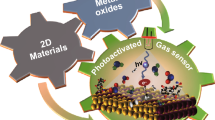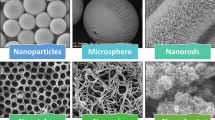Abstract
Thin films of CdSe-based core-shell type quantum dots (CdSe/CdZnS, CdSe/ZnS and CdSeTe/ZnS) deposited on glass substrate were found to undergo a reversible change in photoluminescence (PL) on exposure to ozone in concentrations as low as 0.1 ppm in air. PL decreased rapidly on adding ozone and fully recovered after changing back to pure air. The PL of the CdSe/ZnS quantum dots (QDs) was not quenched by pure oxygen, nitrogen, argon, carbon dioxide, and air containing hydrogen. A comparison of various CdSe-based core-shell type QDs with different emission colors showed that green-emitting QDs with smaller size were more sensitive to ozone, while red-emitting QDs (of larger size) were more resistant to high concentrations of ozone. The response time of the sensor (for a 90 % signal change) was in the order of 10–20 min. The reversible, reproducible and selective response to ozone at room temperature under atmospheric pressure suggested that these QDs have a great potential in terms of fluorescent sensing of ozone.

Thin films of CdSe-based core-shell type QDs showed reversible change in photoluminescence (PL) by O3 in concentration as low as 0.1 ppm in air at room temperature. The PL is not affected by O2, N2, Ar, CO2, or H2







Similar content being viewed by others
References
Eguchi K (1992) Optical gas sensors. In: Sberveglieri G (ed) Gas Sensors. Kluwer, Dordrecht, pp. 307–328
Ando M (2006) Recent advances in optochemical sensors for the detection of H2, O2, O3, CO, CO2 and H2O in air. TrAC: Trends Anal Chem 25:937–948
Wang XD, Wolfbeis OS (2012) Fiber-optic chemical sensors and biosensors (2008-2012). Anal Chem 85:487–508
Hodgkinson J, Tatam RP (2013) Optical gas sensing: a review. Meas Sci Technol 24:Paper No. 012004, 1–95
Takada T (1989) Ozone detection by In2O3 thin film gas sensor. In: Seiyama T (ed) Chemical sensor technology, vol. 2. Kodansha, Tokyo, pp 59–70
Ozone and its application. Int. Ozone Assoc., http://www.ioa-ea3g.org/ozonethemes/ozone-and-its-application.html. Accessed 12 May 2016
Menzel DB (1984) Ozone: an overview of its toxicity in man and animals. J Toxicol Environ Health 13:183–204
Lippmann M (1989) Health effects of ozone a critical review. JAPCA: J Air Pollution Control Assoc 39:672–695
Horstman DH, Levaggi DA, Appel BR, Kothny EL, Wendt JG (1989) Continuous monitoring of ozone in the atmosphere. In: Lodge JP Jr (ed) Methods of Air Sampling and Analysis, 3rd edn. Lewis, Chelsea, pp. 422–426
Birdsall CM, Jenkins AC, Spadinger E (1952) Iodometric determination of ozone. Anal Chem 24:662–664
(2013) Gas detection tubes and sampling handbook, 2nd edn. RAE Systems by Honeywell, TB-1001-02, p 80
Straka MR, Gordon G, Pacey GE (1985) Residual aqueous ozone determination by gas diffusion flow injection analysis. Anal Chem 57:1799–1803
Nederbragt GW, van der Horst A, van Duijn T (1965) Rapid ozone determination near an accelerator. Nature 206:87
Bersis D, Vassiliou E (1966) A chemiluminescence method for determining ozone. Analyst 91:499–505
Takada T, Suzuki K, Nakane M (1993) Highly sensitive ozone sensor. Sensors Actuators B 13:404–407
Penrose W, Pan L, Stetter J, Ollison W (1995) Sensitive measurement of ozone using amperometric gas sensors. Anal Chim Acta 313:209–219
Ando M, Swart C, Pringsheim E, Mirsky VM, Wolfbeis OS (2002) Optical ozone detection by use of polyaniline film. Solid State Ionics 152–153:819–822
Ando M, Swart C, Pringsheim E, Mirsky VM, Wolfbeis OS (2005) Optical ozone-sensing properties of poly(2-chloroaniline), poly(N-methylaniline) and polyaniline films. Sensors Actuators B 108:528–534
Weller H (1993) Colloidal semiconductor q-particles: chemistry in the transition region between solid state and molecules. Angew Chem Int Ed Eng 32:41–53
Murray CB, Norris DJ, Bawendi MG (1993) Synthesis and characterization of nearly monodisperse CdE (E = S, Se, Te) semiconductor nanocrystallites. J Am Chem Soc 115:8706–8715
Dabbousi BO, Rodriguez-Viejo J, Mikulec FV, Heine JR, Mattoussi H, Ober R, Jensen KF, Bawendi MG (1997) (CdSe)ZnS core-shell quantum dots: synthesis and characterization of a size series of highly luminescent nanocrystallites. J Phys Chem B 101:9463–9475
Talapin DV, Rogach AL, Kornowski A, Haase M, Weller H (2001) Highly luminescent monodisperse CdSe and CdSe/ZnS nanocrystals synthesized in a hexadecylamine-trioctylphosphine oxide-trioctylphospine mixture. Nano Lett 1:207–211
Gaponik N, Talapin DV, Rogach AL, Hoppe K, Shevchenko EV, Kornowski A, Eychmüller A, Weller H (2002) Thiol-capping of CdTe nanocrystals: an alternative to organometallic synthetic routes. J Phys Chem B 106:7177–7185
Bruchez M, Moronne M, Gin P, Weiss S, Alivisatos AP (1998) Semiconductor nanocrystals as fluorescent biological labels. Science 281:2013–2018
Anikeeva PO, Halpert JE, Bawendi MG, Bulović V (2009) Quantum dot light-emitting devices with electroluminescence tunable over the entire visible spectrum. Nano Lett 9:2532–2536
Biju V (2014) Chemical modifications and bioconjugate reactions of nanomaterials for sensing, imaging, drug delivery and therapy. Chem Soc Rev 43:744–764
Wuister SF, de Mello Donegá C, Meijerink A (2004) Influence of thiol capping on the exciton luminescence and decay kinetics of CdTe and CdSe quantum dots. J Phys Chem B 108:17393–17397
Zhu H, Hu MZ, Shao L, Yu K, Dabestani R, Zaman MdB, Liao S (2014) Synthesis and optical properties of thiol functionalized CdSe/ZnS (core/shell) quantum dots by ligand exchange. J Nanomater 324972:1–14
Munro AM, Ginger DS (2008) Photoluminescence quenching of single CdSe nanocrystals by ligand adsorption. Nano Lett 8:2585–2590
Breus VV, Heyes CD, Nienhaus GU (2007) Quenching of CdSe-ZnS core-shell quantum dot luminescence by water-soluble thiolated ligands. J Phys Chem C 111:18589–18594
Jorge P, Martins MA, Trindade T, Santos JL, Farahi F (2007) Optical fiber sensing using quantum dots. Sensors 7:3489–3534
Frasco MF, Chaniotakis N (2009) Semiconductor quantum dots in chemical sensors and biosensors. Sensors 9:7266–7286
Saren AA, Kuznetsov SN, Kuznetsov AS, Gurtov VA (2011) Excitonic chemiluminescence in Si and CdSe nanocrystals induced by their interaction with ozone. ChemPhysChem 12:846–853
Yang P, Ando M, Taguchi T, Murase N (2011) Highly luminescent CdSe/CdxZn1–xS quantum dots with narrow spectrum and widely tunable wavelength. J Phys Chem C 115:14455–14460
Li C, Murase N (2005) Surfactant-dependent photoluminescence of CdTe nanocrystals in aqueous solution. Chem Lett 34:92–93
Tansakul C, Lilie E, Walter ED, Rivera III F, Wolcott A, Zhang JZ, Millhauser GL, Braslau R (2010) Distance-dependent fluorescence quenching and binding of CdSe quantum dots by functionalized nitroxide radicals. J Phys Chem C 114:7793–7805
Acknowledgments
This work was supported in part by JSPS KAKENHI Grant Number 26410201 (to M. Ando and Y. Shigeri) and 15H01099 (to V. Biju), and LIXIL JS Foundation Research Grant Number 13-05 (to M. Ando).
Author information
Authors and Affiliations
Corresponding authors
Rights and permissions
About this article
Cite this article
Ando, M., Kamimura, T., Uegaki, K. et al. Sensing of ozone based on its quenching effect on the photoluminescence of CdSe-based core-shell quantum dots. Microchim Acta 183, 3019–3024 (2016). https://doi.org/10.1007/s00604-016-1938-9
Received:
Accepted:
Published:
Issue Date:
DOI: https://doi.org/10.1007/s00604-016-1938-9




